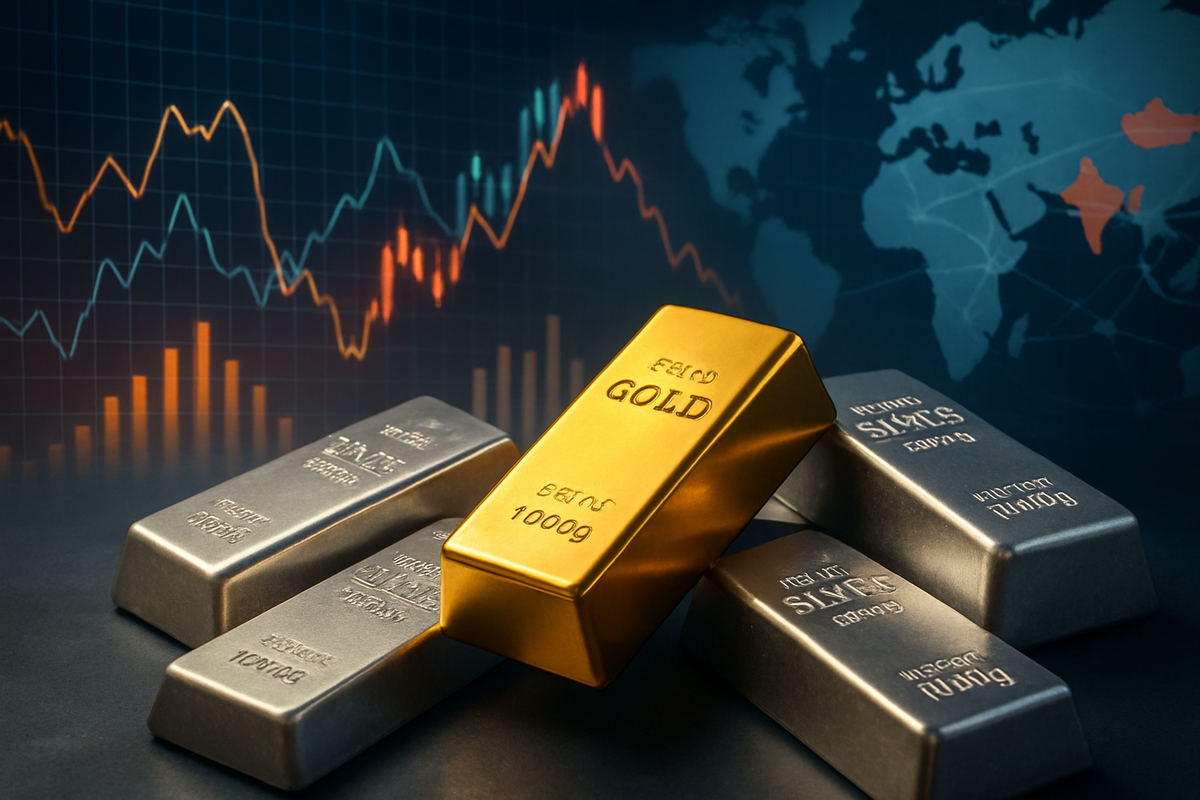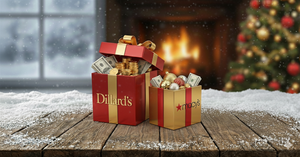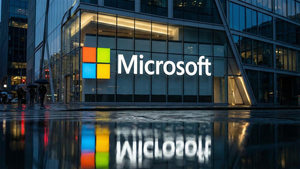
Gold and silver markets are currently navigating a period of intense volatility, with prices experiencing significant swings driven by the anticipation of crucial US inflation data and evolving international trade dynamics. As of October 22, 2025, investors are on edge, keenly awaiting the delayed September US Consumer Price Index (CPI) report, which is expected to heavily influence the Federal Reserve's interest rate trajectory. Concurrently, the delicate dance of US-China trade relations and the promising, albeit less direct, India-US trade talks are injecting further uncertainty and opportunity into the precious metals landscape, challenging their recent ascent to historic highs.
The immediate catalyst for the current market turbulence is the upcoming US Consumer Price Index (CPI) report for September 2025, now scheduled for release on October 24, 2025, at 8:30 AM Eastern Time. This critical economic indicator, originally delayed due to a US government shutdown, is paramount in shaping expectations for the Federal Reserve's monetary policy. Economists, according to a Reuters poll, largely anticipate a 25-basis-point rate cut by the Fed next week, with another likely in December, provided core inflation holds steady at an expected 3.1%. Gold, a non-yielding asset, typically thrives in a lower interest rate environment as the opportunity cost of holding it diminishes. Therefore, a hotter-than-expected inflation figure could temper rate cut expectations, negatively impacting precious metals, while softer data could reinforce the dovish outlook, offering support.
Compounding the inflation narrative are the fluid international trade relations, particularly between the US and China. On October 21st and 22nd, 2025, gold and silver witnessed a sharp sell-off, largely attributed to easing tensions and optimism surrounding a potential US-China trade deal. US President Donald Trump had signaled positive prospects for a "fair" deal with Chinese President Xi Jinping during their impending meeting in South Korea. This sentiment diminished the safe-haven appeal of gold and silver, leading to significant profit-taking after the metals had rallied to unprecedented levels. Gold experienced its largest single-day percentage decline in over a decade, plummeting by 6-6.3%, while silver saw a drop of 4.2-9%. However, late on October 22nd, renewed fears emerged regarding potential new US restrictions on exports to China, paradoxically triggering a late-day recovery in gold and silver, underscoring their role as hedges against geopolitical and economic uncertainty.
Meanwhile, a potential India-US trade deal is also taking shape, with reports suggesting significant reductions in US tariffs on Indian exports, potentially from 50% to 15-16%. A key component of this negotiation involves India gradually reducing its reliance on Russian oil. While this agreement holds substantial implications for sectors like Indian gems and diamond jewelry and could foster broader economic goodwill, its direct immediate impact on global gold and silver prices is less pronounced. However, reports from October 23, 2025, indicated a rise in gold prices on India's Multi Commodity Exchange (MCX) amid these trade deal expectations, hinting at an indirect positive influence through improved trade sentiment or a stronger Indian currency. The immediate market reaction has been characterized by a sharp correction and widespread profit-taking. Gold and silver underwent a dramatic sell-off on October 21st and 22nd, 2025, following earlier rallies that saw gold hit an all-time international high of $4,381.21 per ounce and silver reach $54.47 per ounce around mid-October. The subsequent decline saw gold trading near $4,130 and silver around $48.97 on October 22nd. A strengthening US dollar further contributed to the metals' depreciation, making them more expensive for international buyers. Despite the significant declines, prices showed signs of stabilization by the close of October 22nd, with many analysts viewing this correction as a "healthy reset" within a broader long-term bullish trend rather than a fundamental reversal.
Corporate Fortunes in Flux: Winners and Losers in the Precious Metals Market
The current volatility in gold and silver prices, driven by evolving US inflation data and the dynamics of US-China and India-US trade deals, creates both opportunities and challenges for various publicly traded companies. Those with direct exposure to precious metals are particularly sensitive to these shifts.
Gold and silver mining companies are often direct beneficiaries of rising precious metal prices. As their core product appreciates, so does their revenue and profitability. Companies like Newmont Corporation (NYSE: NEM), Barrick Gold Corporation (NYSE: GOLD), Hecla Mining Company (NYSE: HL), Pan American Silver Corp. (NASDAQ: PAAS), and First Majestic Silver Corp. (NYSE: AG) would see their valuations and earnings bolstered by sustained high prices or a rebound. Similarly, precious metals streaming and royalty companies such as Wheaton Precious Metals Corp. (NYSE: WPM), Franco-Nevada Corporation (NYSE: FNV), and Royal Gold, Inc. (NASDAQ: RGLD) stand to gain significantly. Their business model, which involves providing upfront financing to miners in exchange for future production at fixed, low prices or royalties, offers leveraged exposure to rising commodity prices with reduced operational risk. Exchange-Traded Funds (ETFs) that track physical metals like SPDR Gold Shares (NYSE: GLD) and iShares Silver Trust (NYSE: SLV), or invest in mining companies like VanEck Vectors Gold Miners ETF (NYSE: GDX), also offer investors avenues to benefit from price appreciation.
Conversely, companies that utilize gold and silver as raw materials for their products may experience increased costs during periods of rising precious metal prices, potentially squeezing profit margins if these costs cannot be fully passed on to consumers. Jewelry retailers and manufacturers are particularly vulnerable. Major players like Signet Jewelers Limited (NYSE: SIG), Movado Group Inc. (NYSE: MOV), and Birks Group Inc. (NYSE: BGI) could face headwinds from higher input costs, especially if consumer demand for luxury goods softens. Indian jewelers such as Titan Company Ltd, Kalyan Jewellers India Ltd, and PC Jeweller Ltd also face similar pressures, although cultural demand in India often provides some resilience. Furthermore, industrial users of silver, spanning electronics manufacturers, solar panel producers, and medical device companies, could see their production costs rise. While industrial demand for silver, particularly in green technologies like 5G infrastructure and electric vehicles, is projected to grow, sharply increasing silver prices could impact the profitability of companies within these sectors that rely on silver as a key component.
Broader Currents: Inflation, Trade, and the Enduring Appeal of Precious Metals
The interplay of US inflation data and international trade deals holds wider significance, fitting into broader industry trends, creating ripple effects across markets, and carrying substantial regulatory and historical weight. Precious metals, particularly gold and silver, continue to serve as critical barometers and hedges in this complex global financial landscape.
Gold's role as an inflation hedge is a well-established historical precedent. When fiat currencies lose purchasing power due to inflation, investors historically flock to tangible assets like gold, whose limited supply (increasing only 1-2% annually) stands in stark contrast to easily printed currencies. The 1970s stagflation era, where gold prices surged from $35 to over $800 per ounce, and the post-2008 financial crisis period, which saw gold hit record levels by 2011 amid inflation fears, serve as powerful reminders. As of October 2025, gold's remarkable 56-65% rise year-to-date is partly underpinned by persistent inflation concerns. Silver, platinum, and palladium also act as inflation hedges, with silver's dual role as an industrial metal adding another layer of complexity. The Federal Reserve's interest rate policies are intrinsically linked; lower rates reduce the opportunity cost of holding non-yielding gold, making upcoming CPI data a pivotal event.
International trade deals and tensions, particularly between the US and China, significantly influence market sentiment and safe-haven demand. Trade wars, by creating economic uncertainty and weakening currencies, historically push investors towards gold and silver. The US-China trade war of 2025, which saw gold prices surge dramatically, is a recent example. Conversely, easing tensions, as witnessed on October 21-22, 2025, can lead to profit-taking and a temporary decline in precious metal prices as risk appetite returns. India's substantial role as a gold importer means that trade deals, such as the potential India-US agreement, can indirectly affect global prices through changes in local demand and currency strength, even if direct global impacts are less immediate. Regulatory and policy implications are profound: central bank monetary policy (interest rates, quantitative easing) directly impacts precious metal appeal, while trade tariffs introduce inflationary pressures and economic uncertainty, bolstering safe-haven demand. Government shutdowns, like the one delaying the CPI report, create uncertainty, and even discussions about revaluing gold from statutory to market prices could have far-reaching effects.
Broader industry trends also reinforce the long-term bullish outlook for precious metals. The escalating demand for green technologies—electric vehicles, solar panels, and advanced electronics—is driving significant industrial demand for silver, platinum, and palladium. Silver, in particular, is experiencing explosive demand in solar energy and AI-powered tech. Geopolitical uncertainty, coupled with aggressive gold accumulation by central banks (especially in emerging economies), continues to bolster gold's safe-haven status and provide a strong demand floor. The global precious metal market is projected to grow robustly, from USD 302.79 billion in 2025 to USD 545.57 billion by 2034, at a CAGR of 6.77%, with Asia Pacific remaining a dominant force. These factors, alongside historical precedents of precious metals preserving wealth during economic distress and policy risks, underscore their enduring significance in the global financial system.
The Road Ahead: Navigating Opportunities and Challenges
As the financial markets brace for the upcoming inflation data and monitor the delicate dance of international trade, the path forward for gold and silver presents both short-term challenges and compelling long-term opportunities. Investors will need to remain agile, adapting to rapidly shifting economic and geopolitical landscapes.
In the short-term (Q4 2025), gold and silver are expected to remain volatile. The immediate focus is on the US September CPI report (October 24, 2025). A hotter-than-expected inflation figure could briefly strengthen the US Dollar and temper gold's ascent if it delays anticipated Fed rate cuts. Conversely, softer inflation could bolster gold and silver by reinforcing expectations of aggressive monetary easing. Developments in US-China trade relations will also dictate sentiment; any breakdown in talks could trigger a sharp rebound in safe-haven demand, while further progress might lead to continued consolidation. For silver, its strong industrial demand base, particularly from green technologies, is expected to provide a robust floor against significant short-term declines, even during periods of reduced safe-haven interest.
Looking long-term (2026 and beyond), the outlook for both gold and silver remains overwhelmingly bullish. Major financial institutions project gold to reach $4,700-$5,000 per ounce and silver to average $65 per ounce by 2026. This optimism is fueled by several factors: persistent global inflation concerns, anticipated further interest rate cuts by the Federal Reserve, ongoing geopolitical uncertainties, and relentless central bank gold accumulation. For silver, the accelerating industrial demand from solar energy, electric vehicles, and AI-powered electronics, coupled with a structural supply deficit since 2021, positions it for significant long-term growth. Strategic pivots for investors include viewing recent corrections as "buy the dip" opportunities, recognizing precious metals' role as crucial hedges against inflation and currency debasement, and capitalizing on the strong industrial demand driving silver. Challenges include continued short-term volatility, the potential for a strong US Dollar to exert downward pressure, and improving market sentiment diverting capital to riskier assets.
A Comprehensive Wrap-Up: What Investors Should Watch For
The current financial narrative for gold and silver is one of immediate turbulence within a broadly bullish long-term trend. The anticipation of US inflation data and the fluid nature of international trade deals are the primary market movers, dictating short-term price action and investor sentiment.
Key takeaways from the recent market activity include the dramatic, yet potentially healthy, correction in gold and silver prices on October 21-22, 2025, following record highs. This pullback was driven by profit-taking, a strengthening US dollar, and optimism surrounding US-China trade talks. However, the underlying fundamentals supporting precious metals—persistent inflation concerns, expectations of Federal Reserve rate cuts, ongoing geopolitical risks, and robust industrial demand for silver—remain firmly in place, suggesting that this correction may be a temporary pause rather than a reversal.
Moving forward, the market will closely scrutinize the US September CPI report on October 24, 2025, for clues on the Federal Reserve's monetary policy path. Any signs of persistent inflation could reinforce gold's appeal, while a softer reading might solidify expectations for rate cuts, also benefiting precious metals. Investors should also pay close attention to headlines regarding US-China trade negotiations; a successful deal could temporarily dampen safe-haven demand, while a breakdown could trigger a sharp rally. The consistent gold accumulation by central banks, particularly in emerging markets, will continue to provide a significant demand floor. For silver, its burgeoning industrial applications in green technologies will be a crucial driver, potentially decoupling some of its price action from gold's purely safe-haven characteristics.
In the coming months, investors should watch for further signals from the Federal Reserve regarding interest rate policy, the outcome of key international trade discussions, and any escalation or de-escalation of global geopolitical tensions. The current market environment, characterized by both uncertainty and strong underlying demand, underscores the enduring significance of gold and silver as essential components of a diversified investment portfolio, acting as a store of value and a hedge against broader economic volatility.
This content is intended for informational purposes only and is not financial advice






